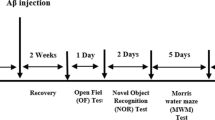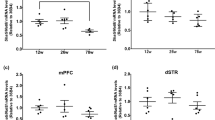Abstract
Extracellular superoxide dismutase (EC-SOD) controls the availability of extracellular superoxide and appears to play a role in controlling oxidative stress and intercellular signaling. Whether EC-SOD overexpression would help or hinder neurobehavioral function appears to depend on the age of the individual. In young adult mice, we have found that EC-SOD overexpression can interfere with learning on the radial-arm maze, possibly by reducing control over nitric oxide neurotransmission. In aged mice, we found, in the current study, that EC-SOD overexpression greatly improves learning on the radial-arm maze. Control (N = 17) and EC-SOD overexpressing mice (N = 13) acquired the 8-arm radial maze over 21 sessions of training. The EC-SOD overexpressing mice had significantly better choice accuracy than the control mice (p < 0.005). The EC-SOD overexpressing mice averaged 6.34 ± 0.22 correct arm entries before an error (entries to repeat) during the acquisition phase, while the control mice averaged 5.18 ± 0.22 entries to repeat. EC-SOD genotype did not cause a main effect on response latency. The advantage held by the EC-SOD overexpressing mice persisted during the eight-session post-acquisition phase of testing (p < 0.01). When there was a shift from high to low levels of motivation by reducing the period of food restriction before testing, the EC-SOD overexpression-induced improvement was reduced slightly, but it was still significant compared with the wild-type controls (p < 0.025). Then, after 4 months of no testing, the mice were tested for retention and reacquisition of performance on the radial-arm maze. The EC-SOD overexpressing mice maintained their significantly better choice accuracy (p < 0.05). Enhancement of EC-SOD activity appears to improve learning and memory performance, specifically in aging mice. EC-SOD mimetic treatment during the course of aging may hold promise for aging-induced cognitive impairment.
Similar content being viewed by others
REFERENCES
Behl, C. (1999). Alzheimer's disease and oxidative stress: Implications for novel therapeutic approaches. Prog. in Neurobiol. 57:301–323.
Brady, T. C., Chang, L. Y., Day, B. I., and Crapo, J. D. (1997). Extracellular superoxide dismutase is upregulated with inducible nitric oxide synthase: After NF-kB activation. Ame. J. Physiol. 273:L1002–L1006.
Durany, N., Munch, G., Michel, T., and Riederer, P. (1999). Investigations on oxidative stress and therapeutical implications in dementia. European Archives of Psychiatry & Clinical Neuroscience 249:68–73.
Keppel, G. (1973). Design and Analysis: A Researcher's Handbook, Prentice Hall, Englewood Cliffs, NJ, pp 430–433.
Levin, E. D., Brady, T. C., Hochrein, E. C., Oury, T. D., Jonsson, L. M., Marklund, S. L., and Crapo, J. D. (1998). Molecular manipulations of extracellular superoxide dismutase: Functional importance for learning. Behav. Genet. 28:381–390.
Levin, E. D., Brucato, F. H., and Crapo, J. D. (2000). Molecular overexpression of extracellular superoxide dismutase increases the dependency of learning and memory performance on motivational state. Behav. Genet. 30:95–100.
Levin, E. D., and Torry, D. (1996). Acute and chronic nicotine effects on working memory in aged rats. Psychopharmacology 123:88–97.
Liang, L. P., Ho, Y. S., Patel, M. (2000). Mitochondrial superoxide production in kainate-induced hippocampal damage. Neuroscience 101:563–570.
Miranda, S., Opazo, C., Larrondo, L. F., Munoz, F. J., Ruiz, F., Leighton, F., and Inestrosa, N. C. (2000). The role of oxidative stress in the toxicity induced by amyloid beta-peptide in Alzheimer's disease. Prog. Neurobiol. 62:633–648.
Oury, T. D., Day, B. J., and Crapo, J. D. (1996). Extracellular superoxide dismutase: A regulator of nitric oxide bioavailability. Lab. Invest. 75:617–636.
Oury, T. D., Ho, Y. S., Piantadosi, C. A., and Crapo, J. D. (1992). Extracellular superoxide dismutase, nitric oxide, and central nervous system O1 toxicity. Proc. Natl. Acad. Sci. USA 89: 9715–9719.
Oury, T. D., Piantadosi, C. A., and Crapo, J. D. (1993). Coldinduced brain edema in mice. Involvement of extracellular superoxide dismutase and nitric oxide. J. Biol. Chem. 268: 15394–15398.
Praticò, D., and Delanty, N. (2000). Oxidative injury in diseases of the central nervous system: Focus on Alzheimer's disease. Ame. J. Med. 109:577–585.
Praticò, D., Uryu, K., Leight, S., Trojanoswki, J. Q., and Lee, V. M-Y. (2001). Increased lipid peroxidation precedes amyloid plaque formation in an animal model of Alzheimer amyloidosis. J. Neurosci. 21:4183–4187.
Sayre, L. M., Smith, M. A., and Perry, G. (2001). Chemistry and biochemistry of oxidative stress in neurodegenerative disease. Current Medicinal Chemistry 8:721–738.
Sheng, H., Bart, R. D., Oury, T. D., Pearlstein, R. D., Crapo, J. D., and Warner, D. S. (1999a). Mice overexpressing extracellular superoxide dismutase have increased resistance to focal cerebral ischemia. Neuroscience 88:185–191.
Sheng, H., Brady, T. C., Pearlstein, R. D., Crapo, J. D., and Warner, D. S. (1999b). Extracellular superoxide dismutase deficiency worsens outcome from focal cerebral ischemia in the mouse. Neuroscience Letters 267:13–16.
Sheng, H., Kudo, M., Mackensen, G. B., Pearlstein, R. D., Crapo, J. D., and Warner, D. S. (2000). Mice overexpressing extracellular superoxide dismutase have increased resistance to global cerebral ischemia. Experimental Neurology 163:392–398.
Smith, M. A., Rottkamp, C. A., Nunomura, A., Raina, A. K., and Perry, G. (2000). Oxidative stress in Alzheimer's disease. Biochimica et Biophysica Acta 1502:139–144.
Thiels, E., Urban, N. N., Gonzalez-Burgos, G. R., Kanterewicz, B. I., Barrionuevo, G., Chu, C. T., Oury, T. D., and Klann, E. (2000). Impairment of long-term potentiation and associative memory in mice that overexpress extracellular superoxide dismutase. J. Neurosci. 20:7631–7639.
Wilkinson, D. (2001). Drugs for treatment of Alzheimer's disease. Inter. J. Clin. Practice 55:129–134.
Author information
Authors and Affiliations
Corresponding author
Rights and permissions
About this article
Cite this article
Levin, E.D., Christopher, N.C., Lateef, S. et al. Extracellular Superoxide Dismutase Overexpression Protects Against Aging-Induced Cognitive Impairment in Mice. Behav Genet 32, 119–125 (2002). https://doi.org/10.1023/A:1015201823417
Issue Date:
DOI: https://doi.org/10.1023/A:1015201823417




